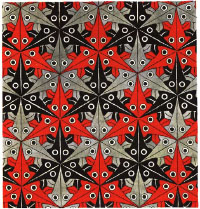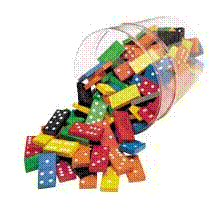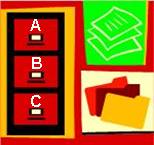
Featured Topic: Tessellations

M.C. Escher is the Dutch artist widely credited with popularizing the tessellating form. Students should definitely view the work of Escher as a part of any math unit on tessellations. This review may include discussion of transformational geometry as students identify whether the tessellating pieces translate (slide), rotate (turn), or reflect (flip) to create each tessellation.
Students may begin their investigation using pattern blocks to identify which of the regular shapes will tessellate the plane. Depending on the age of students, they may combine shapes to find combinations that will tessellate the plane.

Finally, students should be encouraged to develop their own original tessellations in the Escher style. Doing so will definitely increase their admiration for Escher and the many contemporary artists who work in this field. The shapes are rather easy to create. The inspiration to see the character hidden within is a greater challenge for beginners. While the true artists most likely begin with the end in mind, beginners usually create a piece then try to figure out what they have created. This process guarantees a lot of fun and many laughs as students rotate and flip their shapes to figure out just what they could be. Be sure to include the Develop Escher Eyes activity before students attempt their own original tessellations, using the directions also found in this collection.
- View the new Mathwire
 Tessellations collection to view suggestions for introducting the topic and to download Develop Escher Eyes and the directions for creating Escher-style tessellations.
Tessellations collection to view suggestions for introducting the topic and to download Develop Escher Eyes and the directions for creating Escher-style tessellations.

Quilt Square Challenge
Challenge your students to develop spatial sense with this fun mathematical quilting activity. Students use simple squares that are divided on the diagonal, half black and half white. They must assemble the 4 or 9 squares correctly to produce the desired pattern. This activity helps students develop a working knowledge of slides and turns as they attempt to reproduce the larger pattern square by square. Students naturally like to create their own patterns to challenge classmates, so teachers may develop additional patterns to add to their repertoire. Add this activity to your ongoing math center.
- Read more about the
 Quilt Square Challenge for a lesson plan, classroom management suggestions and to download all of the materials needed for this class lesson.
Quilt Square Challenge for a lesson plan, classroom management suggestions and to download all of the materials needed for this class lesson.

Math Manipulatives Series: Investigating Dominoes

The second installment of this series is now online. Math Manipulatives: Investigating Dominoes is a one-stop resource for dominoes that includes games, math-literature connections, problem solving, templates and links to additional online resources to help students use dominoes to develop number sense. Be sure to check out the Domino Fun section at the bottom of this page to view some amazing Domino Art and to master a domino trick that will astound your students!
- View the
 Investigating Dominoes collection.
Investigating Dominoes collection.
- View the
 Investigating Tangrams collection.
Investigating Tangrams collection.

Recent Additions to Mathwire.com
Check the  New on Mathwire.com webpage to see what's new on the site this month.
New on Mathwire.com webpage to see what's new on the site this month.
Check the  Recent Additions to Mathwire.com webpage to see the most recent additions to the site this month.
Recent Additions to Mathwire.com webpage to see the most recent additions to the site this month.
Enter your email address below to receive notifications when new content is added to Mathwire.
NOTICE: If you have already subscribed to the Mathwire.com Updates but have not been receiving any notices, this may be due to your school's e-mail system that does not allow these mailings to be delivered. Please feel free to resubscribe using a different e-mail account rather than your school account.

Mathwire Search Options
New to Mathwire.com? There are several ways to search the site for activities by Math Standard, Math Topic, or using an alphabetical search.
- See
 Searching the Mathwire.com Site for a thorough explanation of these search options.
Searching the Mathwire.com Site for a thorough explanation of these search options.
About Mathwire.com
Mathwire.com is designed to provide activities and appropriate worksheets for teachers to use in their classrooms. All activities and worksheets support the constructivist approach to learning mathematics and the NCTM Standards.
Activities: The activities on this site were developed by Terry Kawas and the teachers in districts where she has worked as a math consultant and coach or with students she has taught in college math-methods courses. The activities are classroom-tested by teachers and appropriate modifications have been made to reflect this field-testing. These activities are posted online in an effort to share quality activities and routines within the mathematics community.
Terms of Use: Teachers are welcome to download any of the activities for free use in their classrooms. No activities may be copied for use on other websites or included in commercial products without permission in writing from Terry Kawas, webmaster. Contact Terry Kawas
